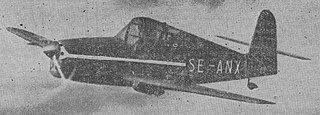
The SAI KZ III Laerke was a Danish light utility aircraft used by the Danish Air Ambulance Service and Danish Air Force.
The Aeronca Model 9 Arrow was a low-wing all-metal cabin monoplane with retractable landing gear. It was marketed to returning pilots from World War II and unveiled in 1947 but never went into production.

The Percival Merganser was a light, civil transport of the late 1940s. It was a twin-engine, high-wing monoplane of all-metal, stressed skin construction with retractable tricycle undercarriage.

The All American 10A Ensign was a two-seat light plane built in the United States shortly after World War II. It was a low-wing, all-metal cantilever monoplane with fixed tricycle undercarriage and which seated its pilot and passenger side by side under an expansive bubble canopy. Due to the glut of military surplus aircraft on the civil market after the war, All American was unable to attract buyers and no production ensued.

The Arado S I was a biplane trainer built in Germany in 1925. The first of three prototypes was powered by a Bristol Lucifer radial engine, while the other two Arado S.Ia aircraft were fitted with the Siemens-Halske Sh 12. The Siemens-Halske Sh 11 powered the Arado S III, a virtually identical aircraft of which only a single prototype was constructed and sold to Turkey.

The Avro 701 Athena is a British advanced trainer aircraft built by Avro in the late 1940s. It was designed to replace the North American Harvard in the Royal Air Force, but was bought only in small numbers, the competing Boulton Paul Balliol being preferred.

The Bartlett LC-13A Zephyr 150 was a United States light civil aircraft built in the 1940s. It was a mid-wing braced monoplane of conventional design with side-by-side seating for two and fixed, tailwheel undercarriage. It was originally marketed as the Babcock LC-13 by its original manufacturer, then as the Taubman LC-13 when the Babcock Airplane Corporation was acquired by Taubman Aircraft. The rights were finally acquired by Bartlett Aircraft in 1941, but plans to mass-produce it were halted by the outbreak of World War II. There was a brief attempt to revive the design at the end of the war, but nothing came of this.

The CNNA HL-6 was a civil trainer aircraft developed in Brazil in 1943.

The Meyers OTW was a 1930s United States training biplane designed by Allen Meyers and built by his Meyers Aircraft Company from 1936 to 1944.

The PZL M-17 "Duduś Kudłacz" was a Polish twin-boom pusher general aviation and trainer aircraft of 1977, which remained a prototype.
The Partenavia P.55 Tornado was a 1950s Italian high-performance competition and touring monoplane built by Partenavia. The Tornado was a small mid-wing cantilever monoplane with a retractable tricycle landing gear. The aircraft was powered by a nose-mounted Lycoming O-320 piston engine.

The SAI KZ IV was a light twin-engined aircraft first built in Denmark in 1944 for use as an air ambulance.
The Letov L-101 was an airliner designed in Czechoslovakia shortly after the end of the Second World War. It was to have been a 12-seat twin-engine feederliner, built using German engines left over from Czechoslovakia's occupation. The Letov factory was nationalised on 24 October 1945, and the L-101 was its first project, along with finishing work on the Junkers Ju 290.
The Renard R.17 was a Belgian four-seat cabin monoplane designed and built by Constructions Aéronautiques G. Renard. The high cantilever wing was an unusual feature when most contemporary aircraft still had braced wings. Designed as a high-speed transport for fresh flowers, no aircraft were ordered and the only R.17 was retained by the company until 1946.

The Mosscraft MA.1 was a British light two-seat low-winged sporting monoplane of the 1930s.
The Aeronca 12AC Chum was a 2-seat cabin monoplane designed and produced by Aeronca in the United States in 1946. The design was a licence-built version of the ERCO Ercoupe.

The Skandinaviska Aero BHT-1 Beauty is a 1940s Swedish single-seat light monoplane designed by E. Bratt, K.E. Hilfing and B.Törnblom and built by Skandinaviska Aero of Stockholm.

The Thaden T-4 Argonaut was a 1930s American four-seat all-metal cabin monoplane built by the Thaden Metal Aircraft Company of San Francisco, California.

The SNCASE SE-1010 was a late 1940s French photo-survey aircraft designed and built by SNCASE for the Institut Géographique National, one prototype was built but it crashed and the project was cancelled.
The Ibis GS-501 Urraco (Magpie) is a Colombian homebuilt aircraft that was designed and produced by Ibis Aircraft of Cali, introduced in 2000. The aircraft is supplied as a complete ready-to-fly-aircraft or as a kit for amateur construction.














